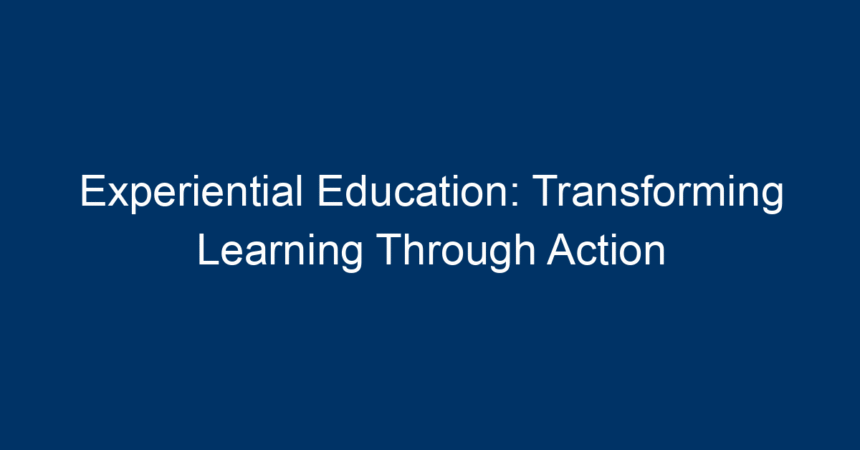Introduction
In a world where traditional education often emphasizes rote memorization and standardized testing, experiential education emerges as a groundbreaking approach to learning. This method encourages students to engage directly with their environment, experience real-life scenarios, and apply their knowledge in practical settings. Whether it’s through internships, service learning, or hands-on projects, experiential education is redefining how we teach and learn. Let’s dive deeper into this transformative educational model and explore its numerous benefits, methodologies, and actionable insights.
Understanding Experiential Education
Experiential education is grounded in the idea that real-world experiences enhance learning far more than theoretical knowledge alone. It emphasizes active participation rather than passive reception. This method is supported by educational theorists like John Dewey and Kurt Lewin, who argued that learning occurs best when students can reflect on their experiences and understand their context.
Key Characteristics of Experiential Education
-
Active Learning: Unlike traditional lecture-based learning, experiential education involves students actively participating in the learning process. This can take many forms, including simulations, role-playing, and real-life problem-solving.
-
Reflection: Critical to experiential education is the reflection process, allowing students to analyze their experiences, draw conclusions, and understand the implications of their actions.
-
Real-World Connections: Experiences are often tied to real-world issues, making the learning relevant and relatable. This connection helps foster a sense of purpose and engagement.
- Collaboration and Communication: Many experiential learning activities require teamwork, encouraging the development of essential social skills alongside academic knowledge.
The Benefits of Experiential Education
1. Enhanced Retention of Knowledge
Studies indicate that students engaged in experiential education retain information more effectively than those in traditional educational settings. By applying what they learn in real-life situations, they form deeper connections with the material. This hands-on approach can lead to increased interest and motivation, as students see the direct impact of their efforts.
2. Development of Critical Thinking Skills
Engaging in experiential learning challenges students to think critically and solve complex problems. As they navigate real-world situations, they encounter obstacles that require innovative solutions, enhancing their analytical skills. This environment promotes questioning and exploration, vital for fostering independent thinkers.
3. Improved Social Skills and Emotional Intelligence
Experiential education often involves teamwork and collaboration. Students learn to respect diverse perspectives and work collectively towards common goals. This exposure cultivates empathy, communication, and conflict resolution skills – essential components of emotional intelligence. These skills are not only beneficial in academic settings but are critical for success in personal and professional lives.
4. Increased Engagement and Motivation
When students participate in experiential learning, they tend to be more engaged and motivated. The excitement of hands-on activities, coupled with the relevance of real-world applications, keeps learners invested in their education. Motivated students are more likely to take initiative, seek out knowledge, and take responsibility for their learning.
Methods of Delivering Experiential Education
1. Service Learning
This method combines community service with academic coursework, allowing students to apply what they’ve learned in a meaningful way. Service learning projects can address various social issues, empowering students to make a positive impact while gaining valuable skills.
2. Internships and Co-op Programs
Internships provide students with hands-on experience in their chosen career paths. Co-op programs, which alternate between periods of academic study and work experience, allow students to integrate classroom knowledge with practical application. Both methods create strong connections between the classroom and professional environments.
3. Project-Based Learning (PBL)
In project-based learning, students engage in a long-term project that requires critical thinking, collaboration, and self-management. This approach encourages them to explore complex questions and develop innovative solutions. PBL is particularly effective in promoting deep understanding and retention of knowledge.
4. Simulations and Role-Playing
Using simulations and role-playing activities allows students to immerse themselves in realistic scenarios. These methods can be particularly effective in fields such as business, healthcare, and social sciences, where real-life decision-making skills are crucial. They create a safe space for students to experiment and learn from their mistakes.
The Challenges of Experiential Education
While experiential education offers numerous advantages, it’s essential to recognize its challenges. These can include:
-
Resource Intensive: Implementing experiential learning opportunities can require significant time, financial resources, and staffing.
-
Assessment Difficulties: Traditional grading systems may not accurately measure a student’s learning in experiential education, necessitating innovative assessment methods.
- Varied Student Engagement: Not all students may respond positively to experiential education, and some may struggle to engage fully. Educators must be prepared to adapt their methods to accommodate diverse learning styles.
Implementing Experiential Education in Your Curriculum
1. Identify Learning Objectives
Begin by clearly defining the learning outcomes you want to achieve through experiential education. Align these with curriculum standards to ensure that they meet educational requirements.
2. Choose Appropriate Activities
Select activities that are relevant to your students’ interests and professions. Ensure that these activities challenge them while also being achievable. Consider incorporating a variety of experiential learning methods, such as service learning, internships, or project-based learning.
3. Foster a Reflective Environment
Encourage students to reflect on their experiences consistently. Facilitate discussions, encourage journaling, and provide constructive feedback to help them process their learning.
4. Collaborate with Community Partners
Build partnerships with local businesses, non-profits, and organizations to create opportunities for students. Collaboration can enhance the relevance of projects and provide additional resources.
5. Train Educators
Ensure that educators are equipped to deliver experiential education effectively. Training in experiential teaching methods, assessment strategies, and facilitation techniques will enhance their confidence and competence in this approach.
Conclusion
Experiential education is more than just a learning method; it is a transformative approach that piques student interest, fosters critical thinking, and encourages meaningful engagement with the world around us. By prioritizing active participation, reflection, and real-world relevance, educators can equip students with the skills necessary for success in an ever-evolving society.
As we continue to embrace this approach, it’s crucial to stay adaptable, considering the diverse needs of our students. By fostering an environment that celebrates experiential learning, we can cultivate a generation of lifelong learners equipped to tackle the challenges of tomorrow.
Actionable Insights
- Start Small: Introduce experiential activities gradually, building up complexity as both you and your students gain confidence.
- Leverage Technology: Utilize digital tools to enhance experiential learning, from virtual simulations to project collaboration platforms.
- Stay Informed: Keep up with trends and research in experiential education to continuously refine your methods and improve student outcomes.
Embrace the power of experiential education, and watch as your students thrive in their learning journeys.




